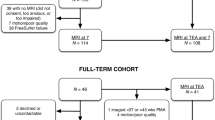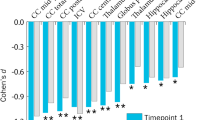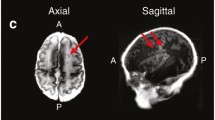Abstract
Preterm birth is associated with increased risk for a spectrum of neurodevelopmental disabilities. The cerebellum is implicated in a wide range of cognitive functions extending beyond sensorimotor control and plays an increasingly recognized role in brain development. Morphometric studies based on volume analyses have revealed impaired cerebellar development in preterm infants. However, the structural covariance between the cerebellum and cerebral cortex has not been studied during the neonatal period, and the extent to which structural covariance is affected by preterm birth remains unknown. In this study, using the structural MR images of 52 preterm infants scanned at term-equivalent age and 312 full-term controls from the Developing Human Connectome Project, we compared volumetric growth, local cerebellum shape development and cerebello-cerebral structural covariance between the two groups. We found that although there was no significant difference in the overall volume measurements between preterm and full-term infants, the shape measurements were different. Compared with the control infants, preterm infants had significantly larger thickness in the vermis and lower thickness in the lateral portions of the bilateral cerebral hemispheres. The structural covariance between the cerebellum and frontal and parietal lobes was significantly greater in preterm infants than in full-term controls. The findings in this study suggested that cerebellar development and cerebello-cerebral structural covariance may be affected by premature birth.



Similar content being viewed by others
Data Availability
Data used in this study was acquired from the second release of the developing Human Connectome Project (dHCP, http://www.developingconnectome.org/).
References
Ohuma EO, Moller AB, Bradley E, Chakwera S, Hussain-Alkhateeb L, Lewin A, Okwaraji YB, Mahanani WR, Johansson EW, Lavin T, Fernandez DE, Domínguez GG, de Costa A, Cresswell JA, Krasevec J, Lawn JE, Blencowe H, Requejo J, Moran AC. National, regional, and global estimates of preterm birth in 2020, with trends from 2010: a systematic analysis. Lancet. 2023;402(10409):1261–71.
Cameron KL, FitzGerald TL, McGinley JL, Allison K, Cheong JLY, Spittle AJ. Motor outcomes of children born extremely preterm; from early childhood to adolescence. Semin Perinatol. 2021;45(8):151481.
Vandormael C, Schoenhals L, Hüppi PS, Filippa M, Borradori TC. Language in preterm born children: atypical development and effects of early interventions on neuroplasticity. Neural Plast. 2019;2019:6873270.
Pascoe L, Burnett AC, Anderson PJ. Cognitive and academic outcomes of children born extremely preterm. Semin Perinatol. 2021;45(8):151480.
Kim SY, Kim E-K, Song H, Cheon J-E, Kim BN, Kim H-S, Shin SH. Association of brain microstructure and functional connectivity with cognitive outcomes and postnatal growth among early school-aged children born with extremely low birth weight. JAMA Netw Open. 2023;6(3):e230198.
Guell X, Schmahmann J. Cerebellar functional anatomy: a didactic summary based on human fMRI evidence. The Cerebellum. 2019;19(1):1–5.
Jacobi H, Faber J, Timmann D, Klockgether T. Update cerebellum and cognition. J Neurol. 2021;268(10):3921–5.
King M. The big role of the ‘little brain’: exploring the developing cerebellum and its role in cognition. Curr Opin Behav Sci. 2023;54:101301.
ten Donkelaar HJ, Lammens M, Wesseling P, Thijssen HO, Renier WO. Development and developmental disorders of the human cerebellum. J Neurol. 2003;250(9):1025–36.
Sathyanesan A, Zhou J, Scafidi J, Heck DH, Sillitoe RV, Gallo V. Emerging connections between cerebellar development, behaviour and complex brain disorders. Nat Rev Neurosci. 2019;20(5):298–313.
Volpe JJ. Commentary — Cerebellar underdevelopment in the very preterm infant: Important and underestimated source of cognitive deficits. J Neonatal-Perinatal Med. 2021;14(4):451–6.
Volpe JJ. Cerebellum of the premature infant: rapidly developing, vulnerable, clinically important. J Child Neurol. 2009;24(9):1085–104.
Poretti A, Boltshauser E, Huisman TA. Prenatal cerebellar disruptions: neuroimaging spectrum of findings in correlation with likely mechanisms and etiologies of injury. Neuroimaging Clin N Am. 2016;26(3):359–72.
Matthews LG, Inder TE, Pascoe L, Kapur K, Lee KJ, Monson BB, Doyle LW, Thompson DK, Anderson PJ. Longitudinal preterm cerebellar volume: perinatal and neurodevelopmental outcome associations. Cerebellum. 2018;17(5):610–27.
Lee W, Al-Dossary H, Raybaud C, Young JM, Morgan BR, Whyte HE, Sled JG, Taylor MJ, Shroff MM. Longitudinal cerebellar growth following very preterm birth. J Magn Reson Imaging. 2016;43(6):1462–73.
Xu F, Ge X, Shi Y, Zhang Z, Tang Y, Lin X, Teng G, Zang F, Gao N, Liu H, Toga AW, Liu S. Morphometric development of the human fetal cerebellum during the early second trimester. Neuroimage. 2020;207:116372.
Ge X, Zheng Y, Qiao Y, Pan N, Simon JP, Lee M, Jiang W, Kim H, Shi Y, Liu M. Hippocampal asymmetry of regional development and structural covariance in preterm neonates. Cereb Cortex. 2022;32(19):4271–83.
Lynch KM, Shi Y, Toga AW, Clark KA. Hippocampal shape maturation in childhood and adolescence. Cereb Cortex. 2019;29(9):3651–65.
Kim H, Gano D, Ho ML, Guo XM, Unzueta A, Hess C, Ferriero DM, Xu D, Barkovich AJ. Hindbrain regional growth in preterm newborns and its impairment in relation to brain injury. Hum Brain Mapp. 2016;37(2):678–88.
Wu Y, Stoodley C, Brossard-Racine M, Kapse K, Vezina G, Murnick J, du Plessis AJ, Limperopoulos C. Altered local cerebellar and brainstem development in preterm infants. Neuroimage. 2020;213:116702.
Diedrichsen J, King M, Hernandez-Castillo C, Sereno M, Ivry RB. Universal transform or multiple functionality? understanding the contribution of the human cerebellum across task domains. Neuron. 2019;102(5):918–28.
Batalle D, Hughes EJ, Zhang H, Tournier JD, Tusor N, Aljabar P, Wali L, Alexander DC, Hajnal JV, Nosarti C, Edwards AD, Counsell SJ. Early development of structural networks and the impact of prematurity on brain connectivity. Neuroimage. 2017;149:379–92.
Herzmann CS, Snyder AZ, Kenley JK, Rogers CE, Shimony JS, Smyser CD. Cerebellar functional connectivity in term- and very preterm-born infants. Cereb Cortex. 2018;29(3):1174–84.
Evans AC. Networks of anatomical covariance. Neuroimage. 2013;80:489–504.
Alexander-Bloch A, Raznahan A, Bullmore E, Giedd J. The convergence of maturational change and structural covariance in human cortical networks. J Neurosci. 2013;33(7):2889–99.
Alexander-Bloch A, Giedd JN, Bullmore E. Imaging structural co-variance between human brain regions. Nat Rev Neurosci. 2013;14(5):322–36.
Morimoto C, Nakamura Y, Kuwabara H, Abe O, Kasai K, Yamasue H, Koike S. Unique morphometric features of the cerebellum and cerebellocerebral structural correlation between autism spectrum disorder and schizophrenia. Biol Psychiatry Glob Open Sci. 2021;1(3):219–28.
Moberget T, Doan NT, Alnæs D, Kaufmann T, Córdova-Palomera A, Lagerberg TV, Diedrichsen J, Schwarz E, Zink M, Eisenacher S, Kirsch P, Jönsson EG, Fatouros-Bergman H, Flyckt L, Pergola G, Quarto T, Bertolino A, Barch D, Meyer-Lindenberg A, Agartz I, Andreassen OA, Westlye LT. Cerebellar volume and cerebellocerebral structural covariance in schizophrenia: a multisite mega-analysis of 983 patients and 1349 healthy controls. Mol Psychiatry. 2017;23(6):1512–20.
Limperopoulos C, Soul JS, Haidar H, Huppi PS, Bassan H, Warfield SK, Robertson RL, Moore M, Akins P, Volpe JJ, du Plessis AJ. Impaired trophic interactions between the cerebellum and the cerebrum among preterm infants. Pediatrics. 2005;116(4):844–50.
Limperopoulos C, Chilingaryan G, Guizard N, Robertson RL, du Plessis AJ. Cerebellar injury in the premature infant is associated with impaired growth of specific cerebral regions. Pediatr Res. 2010;68(2):145–50.
Limperopoulos C, Chilingaryan G, Sullivan N, Guizard N, Robertson RL, du Plessis AJ. Injury to the premature cerebellum: outcome is related to remote cortical development. Cereb Cortex. 2014;24(3):728–36.
Hughes EJ, Winchman T, Padormo F, Teixeira R, Wurie J, Sharma M, Fox M, Hutter J, Cordero-Grande L, Price AN, Allsop J, Bueno-Conde J, Tusor N, Arichi T, Edwards AD, Rutherford MA, Counsell SJ, Hajnal JV. A dedicated neonatal brain imaging system. Magn Reson Med. 2017;78(2):794–804.
Cordero-Grande L, Hughes EJ, Hutter J, Price AN, Hajnal JV. Three-dimensional motion corrected sensitivity encoding reconstruction for multi-shot multi-slice MRI: application to neonatal brain imaging. Magn Reson Med. 2018;79(3):1365–76.
Kuklisova-Murgasova M, Quaghebeur G, Rutherford MA, Hajnal JV, Schnabel JA. Reconstruction of fetal brain MRI with intensity matching and complete outlier removal. Med Image Anal. 2012;16(8):1550–64.
Makropoulos A, Robinson EC, Schuh A, Wright R, Fitzgibbon S, Bozek J, Counsell SJ, Steinweg J, Vecchiato K, Passerat-Palmbach J, Lenz G, Mortari F, Tenev T, Duff EP, Bastiani M, Cordero-Grande L, Hughes E, Tusor N, Tournier JD, Hutter J, Price AN, Teixeira R, Murgasova M, Victor S, Kelly C, Rutherford MA, Smith SM, Edwards AD, Hajnal JV, Jenkinson M, Rueckert D. The developing human connectome project: a minimal processing pipeline for neonatal cortical surface reconstruction. Neuroimage. 2018;173:88–112.
Makropoulos A, Aljabar P, Wright R, Huning B, Merchant N, Arichi T, Tusor N, Hajnal JV, Edwards AD, Counsell SJ, Rueckert D. Regional growth and atlasing of the developing human brain. Neuroimage. 2016;125:456–78.
Schuh A, Makropoulos A, Wright R, Robinson EC, Tusor N, Steinweg J, Hughes E, Grande LC, Price A, Hutter J, Hajnal JV, Rueckert D. A deformable model for the reconstruction of the neonatal cortex. IEEE 14th International Symposium on Biomedical Imaging (ISBI 2017); 2017. pp. 800–3.
Bozek J, Makropoulos A, Schuh A, Fitzgibbon S, Wright R, Glasser MF, Coalson TS, O’Muircheartaigh J, Hutter J, Price AN, Cordero-Grande L, Teixeira RPAG, Hughes E, Tusor N, Baruteau KP, Rutherford MA, Edwards AD, Hajnal JV, Smith SM, Rueckert D, Jenkinson M, Robinson EC. Construction of a neonatal cortical surface atlas using multimodal surface matching in the developing human connectome project. Neuroimage. 2018;179:11–29.
Robinson EC, Jbabdi S, Glasser MF, Andersson J, Burgess GC, Harms MP, Smith SM, Van Essen DC, Jenkinson M. MSM: a new flexible framework for multimodal surface matching. Neuroimage. 2014;100:414–26.
Shi Y, Lai R, Morra JH, Dinov I, Thompson PM, Toga AW. Robust surface reconstruction via Laplace-Beltrami eigen-projection and boundary deformation. IEEE Trans Med Imaging. 2010;29(12):2009–22.
Shi Y, Lai R, Wang DJ, Pelletier D, Mohr D, Sicotte N, Toga AW. Metric optimization for surface analysis in the Laplace-Beltrami embedding space. IEEE Trans Med Imaging. 2014;33(7):1447–63.
Shi Y, Morra JH, Thompson PM, Toga AW. Inverse-consistent surface mapping with Laplace-Beltrami eigen-features. International Conference on Information Processing in Medical Imaging. Springer; 2009. pp. 467–78.
Wee CY, Yap PT, Shen D. Prediction of Alzheimer’s disease and mild cognitive impairment using cortical morphological patterns. Hum Brain Mapp. 2012;34(12):3411–25.
Sha Z, van Rooij D, Anagnostou E, Arango C, Auzias G, Behrmann M, Bernhardt B, Bolte S, Busatto GF, Calderoni S, Calvo R, Daly E, Deruelle C, Duan M, Duran FLS, Durston S, Ecker C, Ehrlich S, Fair D, Fedor J, Fitzgerald J, Floris DL, Franke B, Freitag CM, Gallagher L, Glahn DC, Haar S, Hoekstra L, Jahanshad N, Jalbrzikowski M, Janssen J, King JA, Lazaro L, Luna B, McGrath J, Medland SE, Muratori F, Murphy DGM, Neufeld J, O’Hearn K, Oranje B, Parellada M, Pariente JC, Postema MC, Remnelius KL, Retico A, Rosa PGP, Rubia K, Shook D, Tammimies K, Taylor MJ, Tosetti M, Wallace GL, Zhou F, Thompson PM, Fisher SE, Buitelaar JK, Francks C. Subtly altered topological asymmetry of brain structural covariance networks in autism spectrum disorder across 43 datasets from the ENIGMA consortium. Mol Psychiatry. 2022;27(4):2114–25.
Brossard-Racine M, McCarter R, Murnick J, Tinkleman L, Vezina G, Limperopoulos C. Early extra-uterine exposure alters regional cerebellar growth in infants born preterm. NeuroImage: Clinical. 2019;21:101646.
Andescavage NN, du Plessis A, McCarter R, Serag A, Evangelou I, Vezina G, Robertson R, Limperopoulos C. Complex trajectories of brain development in the healthy human fetus. Cereb Cortex. 2017;27(11):5274–83.
Elnakib A, Soliman A, Nitzken M, Casanova M, Gimel’farb G, El-Baz A. Magnetic resonance imaging findings for dyslexia: a review. J Biomed Nanotechnol. 2014;10:2778–805.
Hodge SM, Makris N, Kennedy DN, Caviness VS, Howard J, McGrath L, Steele S, Frazier JA, Tager-Flusberg H, Harris GJ. Cerebellum, language, and cognition in autism and specific language impairment. J Autism Dev Disord. 2009;40(3):300–16.
Cherbuin N, Réglade-Meslin C, Kumar R, Sachdev P, Anstey KJ. Mild cognitive disorders are associated with different patterns of brain asymmetry than normal aging: the PATH through life study. Front Psychiatry. 2010;1:11.
Sancak S, Gursoy T, Imamoglu EY, Karatekin G, Ovali F. Effect of prematurity on cerebellar growth. J Child Neurol. 2016;31(2):138–44.
Brossard-Racine M, Poretti A, Murnick J, Bouyssi-Kobar M, McCarter R, du Plessis AJ, Limperopoulos C. Cerebellar microstructural organization is altered by complications of premature birth: a case-control study. J Pediatr. 2017;182:28-33.e1.
Stoodley CJ, Schmahmann JD. Evidence for topographic organization in the cerebellum of motor control versus cognitive and affective processing. Cortex. 2010;46(7):831–44.
Buckner RL, Krienen FM, Castellanos A, Diaz JC, Yeo BTT. The organization of the human cerebellum estimated by intrinsic functional connectivity. J Neurophysiol. 2011;106(5):2322–45.
Becker EBE, Stoodley CJ. Autism spectrum disorder and the cerebellum. Neurobiol Autism. 2013:1–34.
Butts T, Green MJ, Wingate RJ. Development of the cerebellum: simple steps to make a “little brain.” Development. 2014;141(21):4031–41.
D’Mello AM, Stoodley CJ. Cerebro-cerebellar circuits in autism spectrum disorder. Front Neurosci. 2015;9:408.
Allin MPG, Salaria S, Nosarti C, Wyatt J, Rifkin L, Murray RM. Vermis and lateral lobes of the cerebellum in adolescents born very preterm. NeuroReport. 2005;16(16):1821–4.
Kim SY, Liu M, Hong S-J, Toga AW, Barkovich AJ, Xu D, Kim H. Disruption and compensation of sulcation-based covariance networks in neonatal brain growth after perinatal injury. Cereb Cortex. 2020;30(12):6238–53.
Mitelman SA, Buchsbaum MS, Brickman AM, Shihabuddin L. Cortical intercorrelations of frontal area volumes in schizophrenia. Neuroimage. 2005;27(4):753–70.
Brodal P. The corticopontine projection in the rhesus monkey. Origin and principles of organization. Brain. 1978;101(2):251–83.
Schmahmann JD, Pandya DN. Anatomical investigation of projections to the basis pontis from posterior parietal association cortices in rhesus monkey. J Comp Neurol. 1989;289(1):53–73.
Schmahmann JD, Pandya DN. Anatomic organization of the basilar pontine projections from prefrontal cortices in rhesus monkey. J Neurosci. 1997;17(1):438–58.
O’Reilly JX, Beckmann CF, Tomassini V, Ramnani N, Johansen-Berg H. Distinct and overlapping functional zones in the cerebellum defined by resting state functional connectivity. Cereb Cortex. 2010;20(4):953–65.
Allen G, McColl R, Barnard H, Ringe WK, Fleckenstein J, Cullum CM. Magnetic resonance imaging of cerebellar–prefrontal and cerebellar–parietal functional connectivity. Neuroimage. 2005;28(1):39–48.
Carper RA, Courchesne E. Inverse correlation between frontal lobe and cerebellum sizes in children with autism. Brain. 2000;123(Pt 4):836–44.
Wang X, Xia J, Wang W, Lu J, Liu Q, Fan J, Soondrum T, Yu Q, Tan C, Zhu X. Disrupted functional connectivity of the cerebellum with default mode and frontoparietal networks in young adults with major depressive disorder. Psychiatry Res. 2023;324:115192.
Lundequist A, Böhm B, Lagercrantz H, Forssberg H, Smedler AC. Cognitive outcome varies in adolescents born preterm, depending on gestational age, intrauterine growth and neonatal complications. Acta Paediatr. 2015;104(3):292–9.
Acknowledgements
We would like to thank the Developing Human Connectome Project. The dHCP project was funded by the European Research Council under the European Union Seventh Framework Programme (FR/2007-2013)/ERC Grant Agreement no. 319456.
Funding
This study was supported by the Natural Science Foundation of Shandong Province (No. ZR2021QH052) and the National Natural Science Foundation of China (No. 31771328).
Author information
Authors and Affiliations
Contributions
Conceptualization: S.L., Y.T.; Formal analysis: F.X., Y.W.; Investigation: F.X., W.W.; Visualization: F.X., W.L.; Writing—original draft preparation: F.X., Y.W., W.W., W.L.; Writing—review and editing: F.X., Y.T.; Funding acquisition: F.X., S.L.; Supervision: S.L., Y.T..
Corresponding author
Ethics declarations
Ethical Approval
Data used in this study was acquired from the developing Human Connectome Project. This project was approved by the National Research Ethics Committee; REC: 14/Lo/1169), and written informed consent was obtained from all participating families before imaging.
Competing Interests
The authors declare no competing interests.
Additional information
Publisher's Note
Springer Nature remains neutral with regard to jurisdictional claims in published maps and institutional affiliations.
Rights and permissions
Springer Nature or its licensor (e.g. a society or other partner) holds exclusive rights to this article under a publishing agreement with the author(s) or other rightsholder(s); author self-archiving of the accepted manuscript version of this article is solely governed by the terms of such publishing agreement and applicable law.
About this article
Cite this article
Xu, F., Wang, Y., Wang, W. et al. Preterm Birth Alters the Regional Development and Structural Covariance of Cerebellum at Term-Equivalent Age. Cerebellum (2024). https://doi.org/10.1007/s12311-024-01691-0
Accepted:
Published:
DOI: https://doi.org/10.1007/s12311-024-01691-0




